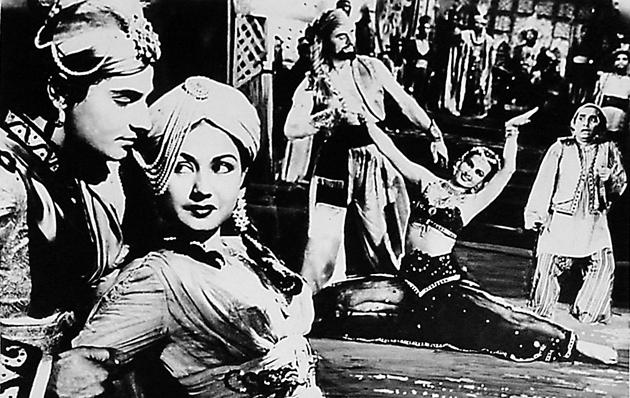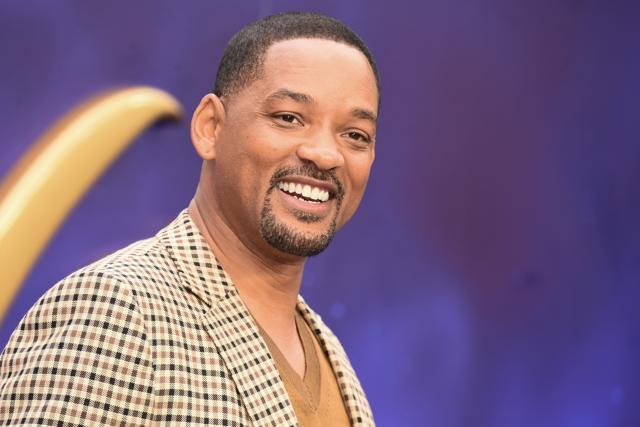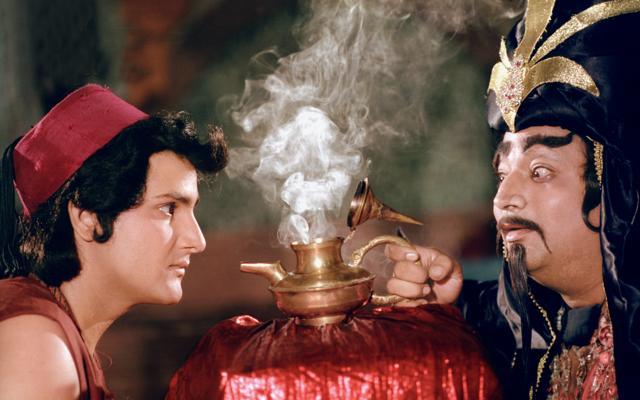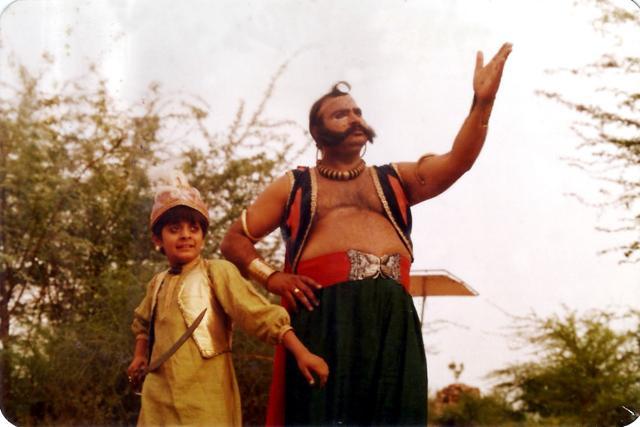Aladdin, the boy from Arabia, loved in India
Hollywood is set to release a new Will Smith-starrer Aladdin movie. But the Arabian Nights story, about a boy and his magic lamp, has a long history of film and TV adaptations in India
Though Dadasaheb Phalke’s short film Raja Harishchandra (1913) is regarded as Indian cinema’s founding moment, a number of film historians believe that Indian cinema may have been born a decade before. Hiralal Sen’s film Ali Baba and Forty Thieves (1903) might be Indian cinema’s point of genesis. Unfortunately, little is known about the film or its existence apart from the fact that it was made.

Sen’s film was a dramatised retelling of a middle-eastern folk tale, a story more popularly known in the Hindi heartland as ‘Ali Baba aur Chaalis Chor’. The tale, part of the collection One Thousand and One Nights, known popularly as Arabian Nights, is one of the two stories that have almost become synonymous, perhaps even indistinguishable from Indian culture. The other one is the story of Aladdin and his magic lamp. As Disney releases its live-action remake of a universally popular character, it is worth remembering that the story of Aladdin has been a crucial part of India’s cultural history, especially its cinema.
Though the stories that constitute the Arabian Nights have their sources in oral traditions of the Arab world, the rather more popular tales like ‘Aladdin’ and ‘Ali Baba’ are ascribed to the first European translator of the texts, Antoine Galland. The popularity and reach of these stories can be calculated from the fact that even before Sen’s film, Urdu and Bengali translations of the stories were available in Indian markets.
The Urdu-Parsi theatres of the day had had been carrying the tales to different corners of India, liberally mixing them with Victorian plays and Shakespearan tropes. Film Historian Rosie Thomas’s book Bombay before Bollywood closely examines this phenomenon. ‘Within India the Arabian Nights fantasy film operated on two levels, perceived not only as local and traditional but also, apparently paradoxically, as international and modern’, she writes.

Aladdin’s biggest cinematic success in India, however, originated on foreign shores. The American fantasy film The Thief of Baghdad (1924), starring Douglas Fairbanks went on to become one of the most successful films to be shown in India. It launched what would soon become the ‘fantasy’ or ‘jadui’ genre of filmmaking in India’s own industry. These films borrowed from multiple sources and were, as Thomas puts it, “coded as quasi-Arabian and/or ancient Iranian, this was in fact a hybrid”. Its scope for magic, romance, spectacle and stunts meant the popularity of the Arabian Nights fantasy film grew spectacularly. “Arabian Nights became somewhat paradoxically, a signifier of cosmopolitan modernity in 1920s and 1930s India”, Thomas suggests.
Other versions
Following the success of the American film, a number of native production houses followed suit with their own versions of Aladdin’s story among other tales from the collection. BP Mishra’s silent film Aladdin and the Wonderful Lamp (1927) was followed by Madan and Sons’ Aladdin (1931). Also referred as the ‘costume’ genre these quasi-Islamicate films had begun to dominate popular imagination; even India’s first talkie Alam Ara (1931) seemed distinctly influenced by motifs from the Arabian Nights.
The arrival of sound meant the move from fantasy to realism. That did not stop Homi Wadia, who in 1952, produced until then, India’s best known adaptation of Aladdin, the widely successful Aladdin and the Wonderful Lamp (1952). Wadia, a well-known fantasist who went on to marry the action star, popularly known as ‘Fearless Nadia’, carried on the work of Wadia Movietone, a banner he had co-founded with his older brother. The last film that Homi Wadia directed and produced was Adventures of Aladdin (1978).
The story of Aladdin hasn’t just fascinated makers in Bollywood or the Hindi belt. The first Telugu and Tamil incarnation of the character arrived with TR Raghunath’s Allavudeenum Arputha Vilakkum, recreated two decades later by IV Sasi with a cast that included stellar names like Kamal Haasan and Rajnikanth.

The Nights’ stories, however, would see their golden days, not on celluloid, but on television. Fresh from having conquered national television with Ramayana, the Sagar brothers launched the mammoth 260-episode long series Alif Laila (Urdu for One Thousand and One Nights). The series went on to become one of the biggest shows in Indian television history. “Our father wanted us to pursue something that was different. I had always loved reading about the Arabian Nights as a kid and the challenge of doing something with costumes and imaginative sets was all the more inviting,” Prem Sagar, son of Ramanand Sagar, says about the series that came a year after the global success of Disney’s animated Aladdin (1992). A year after the animated film, in 1994, Disney’s own animated series on Aladdin was dubbed and played nationwide on Doordarshan’s network.
The reach of the Sagars’ Alif Laila was as incredible as it was challenging. “I was certain I wanted to cast a young, charming face as Aladdin, because I wanted him to be seen as innocent, perhaps even gullible. We were recreating this text on a scale that had never been attempted before. Father said that after we had done something around Hindu culture [Ramayana] we must bring Islamic culture to the mainstream as well. We did our research extensively, our writers were scholars,” Sagar says. Though the show essayed a number of stories from the Arabian Nights collection, predictably its most famous were, Ali Baba and Aladdin. But while Sagar had a studio and around 150 people at his disposal and ‘five floors’ of workspace to work with, the story of Aladdin has driven some ordinary people to cinema as well.

Leap of faith
In 1987, Delhi-based Manu Bhasin quit his family business to work on an Aladdin related script. A novice, Bhasin was desperate to get the film made but had little to no support in infrastructure-deprived Delhi. Desperate, with the help of a few friends, Bhasin along with his family took a leap of faith. “I had no money to put into this project. I couldn’t move to Mumbai because my family was here so I decided to make this film in Delhi itself. My wife, Suman, made the costumes. I cast my own son as Aladdin and for five years we struggled with everything imaginable to complete the film,” Bhasin says.
By 1993, the year when Alif Laila stormed national television, Bhasin’s modest production was complete. The shooting locations included Mehrauli, Faridabad and a school auditorium in Delhi where a temporary set had been erected. The props were self-made. One cave sequence included Bhasin’s son, Anmol, descending into a well in a Delhi factory. “I had lost the will by the time we were done. In fact, cynical as it may sound, I just wanted some return for five years of work,” Bhasin says.
Reprieve came in the form of Doordarshan. The channel bought Bhasin’s film and showed it as a spliced five-episode series titled Aladdin aur Jadui Chirag (1993) in its children’s slot. Bhasin claims it was the first children-centric recreation of an Arabian Nights’ story. Its music was created by then fellow struggler of Bhasin’s, Vishal Bhardwaj. Bhasin himself, never returned to proper filmmaking again.
Aladdin has since been recast in various Indian TV serials, both for children and adults. Sab TV’s Aladdin: Naam toh Suna hoga(2018) has crossed 150 episodes. The story has had rather forgettable mainstream outings like Sujoy Ghosh’s Aladin (2009) as well. While Indian filmmakers continue to grapple with the character’s possibilities, its appeal remains eternal. Sagar believes it has to do with the moralistic side of the stories. “To me the collection of stories, Aladdin especially, is a moralistic lesson. It tells you the difference between good and bad, and the importance of choosing one over the other. I think that is why it became such a huge hit. Not because it was Islamic tones, or had magic in it, but because it was morally relatable,” he says.
In contrast, Bhasin believes he made the film as an ode to his own childhood. “I have always thought the character is made for children, his innocence, is softness is childlike. It tells me about myself, and that is why I always imagined Aladdin as a character that children would want to see,” he says.
Get more updates from Bollywood, Taylor Swift, Hollywood, Music and Web Series along with Latest Entertainment News at Hindustan Times.
Get more updates from Bollywood, Taylor Swift, Hollywood, Music and Web Series along with Latest Entertainment News at Hindustan Times.






